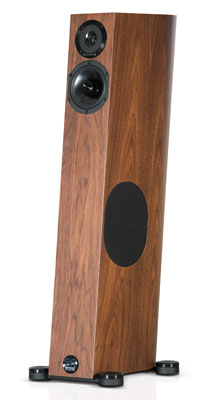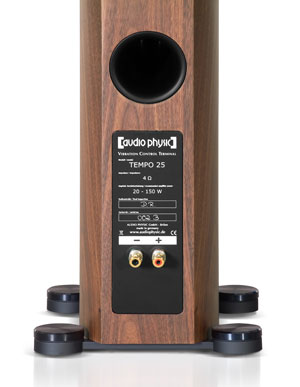| Audio Physics Loudspeakers Model Tempo 25 |
 The Audio Physics line is from Germany where precision engineering
is a way of life. But while there is a lot of engineering
in this design, and though important and of interest to the
manufacturer and some audiophiles, I am of the opinion that
engineering alone does not guarantee good sound. Therefore,
this review is going to focus on the loudspeakers’ performance
and sonic accomplishments when they are used in an audio system
to reproduce music. However, the loudspeakers have numerous
indicators that point at design proficiency and quality, likely
based on Audio Physics’ 25-some years of experience.
I have heard APs at trade shows, but have never auditioned
them under controlled conditions, so I can’t comment
on the company’s history and/or its past achievements.
I do know that they enjoyed good press with the Tempo 25 — the
25th anniversary edition — often compared with the lower
priced Tempo model, both belonging to the company’s high-end
series. AP actually produces 22 models divided into four categories/series
of loudspeakers and includes home theatre components.
The Audio Physics line is from Germany where precision engineering
is a way of life. But while there is a lot of engineering
in this design, and though important and of interest to the
manufacturer and some audiophiles, I am of the opinion that
engineering alone does not guarantee good sound. Therefore,
this review is going to focus on the loudspeakers’ performance
and sonic accomplishments when they are used in an audio system
to reproduce music. However, the loudspeakers have numerous
indicators that point at design proficiency and quality, likely
based on Audio Physics’ 25-some years of experience.
I have heard APs at trade shows, but have never auditioned
them under controlled conditions, so I can’t comment
on the company’s history and/or its past achievements.
I do know that they enjoyed good press with the Tempo 25 — the
25th anniversary edition — often compared with the lower
priced Tempo model, both belonging to the company’s high-end
series. AP actually produces 22 models divided into four categories/series
of loudspeakers and includes home theatre components.
Appearance
The slim, immaculately finished enclosures are stylish and
present a tastefully designed almost understated elegance
that fits almost any decor. They are slightly tilted toward
the rear (for time alignment) boast great single-wiring terminals
and adjustable spikes. For a truly nice final touch, the
supporting structure is covered with four black covers, which
adds to the visual appeal and shows the company’s regard
for precision as well as appearance — a touch of class.
A number of finishes are available — check the AP website.
The Sound
For the initial auditioning session, I had the Tempos connected
to the Genesis power amplifier, pre-amplified with the Allnick
(tube) and a Dolan (solid state) designs, with the source
components an Atoll CD player and Origin Live turntable/arm
with a Dynavector moving coil cartridge and cabling by XLO
and Argentum. Earlier, these electronics had been connected
to a pair of Genesis 5.1 speakers (about $25K) and I have
listened to the system for months thus familiarizing me with
every component’s voice. I reasoned that by simply
replacing the Genesis with the Tempos, I should get a pretty
good first impression and a general idea of the Tempos’ sonic
temperament. Well, it didn’t take long to find the
speakers’ voice, but what should have been routine
for this reviewer, became a bit of a thrill and a lot of
anticipation. Thrill, because the Tempos sounded real good;
and anticipation because I wanted to test them with the other
amplifiers I had at hand — the Bryston 7BSST Squared
monoblocks and the Atoll 400 series integrated amplifier.
With the Genesis power amp, the Tempos sounded entirely relaxed.
I never had the feeling that the amp labored or that there
were restrictions relating to dynamics. Surprisingly smooth
highs, clear midrange and solid deep bass made this system
sound musically pleasing with but a few slight upper midrange
dips (around 900 -1000Hz). Outstanding imagery and the speakers’ knack
to delineate detail, led me to believe that I am actually hearing
the amplifier’s characteristics, while the loudspeakers
faithfully reproduced the musical signal they received. That’s
a good thing, of course. With the Bryston 7BSST-Squared connected,
the Tempo 25s didn’t sound as relaxed as with the Genesis
amp and, in fact, exhibited a bit of tension — the kind
that borders on anticipation for things to happen. When I played
back my favourite Beethoven recording of the 5th with Fritz
Reiner and the Chicago Symphony (JVC CD) my anticipation turned
into appreciation as the speakers faithfully reproduced this
very complex musical material. Basses and cellos —stage
right, violas in the centre, first violins —stage left,
percussion way back centre and horns and woodwinds just in
front of the percussions. In other words, the loudspeakers
easily recreated the space, the position of all instruments
and the many subtle tonal shades and dynamics of the 50-some-piece
orchestra. While I heard plenty of detail, I was impressed
with the way it was presented, not as a highlight, but as a
beautifully realistic blend and part of the orchestral arrangement.
The loudspeakers’ ability to recreate a solid three-dimensional
soundstage image was in the same league as the one I recently
enjoyed at a live performance at the famous Musikhaus in Vienna.
I believe that the Tempo 25s do not add spatial expansion or
contraction, but do provide the impression of proper boundaries
and out-of-the-box sound that doesn’t seem to emanate
from their slim enclosures. The Bryston amps introduced a little
more bass resolution and a slight increase in harmonics above
fundamentals. The midrange segment from about 170Hz to 1300Hz
was almost the same as with the Genesis amp, but in the mid-highs
from about 2500Hz to 5kHz, the Bryston amps had a warmer tonal
character with additional presence as this relates to harmonics.
Top frequencies were identical with both amps and showed that
the Tempos’ tweeters never sound edgy, extend well into
the dog-whistle range and handle harmonics — the element
that provides listeners with the essence of instrumental timbre
and tone. Goes to show — there is never too much power
even with an efficient loudspeaker.
 The Atoll integrated amplifier, when connected to the Tempo
25s, didn’t impress me. While it did provide decent bass,
mids and highs, this system combination lacked harmonics and
sounded rather clinical (coldish) when compared with the other
two amps. Nevertheless, imaging was great, resolution was in
line with the other amps and I’d call the all-round sound
quite good, but not yet high-end. The Atoll integrated amplifier, when connected to the Tempo
25s, didn’t impress me. While it did provide decent bass,
mids and highs, this system combination lacked harmonics and
sounded rather clinical (coldish) when compared with the other
two amps. Nevertheless, imaging was great, resolution was in
line with the other amps and I’d call the all-round sound
quite good, but not yet high-end.
Synopsis
The Tempo 25s never sounded less than involving with all amp
combinations, thus showing a relatively neutral quality.
Though I didn’t have a good vacuum tube amp in house
with which to try them, I’d say that any such design
would sound great. However, in my system with the 700watt/channel
Bryston 7Bs the Tempos reached peak performance elements
usually reserved for much higher priced designs. Not only
was the bass more harmonious and tighter than with the other
amps, there was more of the midrange presence, better transparency
at top frequencies and significantly better harmonic complement
around fundamental tones. The company’s slogan No Loss
Of Fine Detail is appropriate and spot on.
Commentary
As with all system combinations, it is important pay attention
to every component’s contribution to the end result — the
music. Though manufacturers will make claims about the quality
of their products, and there are, of course, specifications,
it is wise to use the information carefully. It is best to
listen and trust you own ears (or mine). Synergy has no guide
and cooperative interaction is found only by trial and error.
Some folks have developed a sixth sense, but most have to
rely on their audio guru — and he/she could be wrong
as well. Having said this, I believe that the Audio Physics
Temp 25 loudspeakers feature a high degree of sonic neutrality
and allow the electronics — amp, preamp and source
component — to perform at their best (or worst, as
the case may be). Therefore, the sound of your favourite
components will be reproduced rather faithfully. This, of
course allows the end-user to choose the kind of sound he/she
prefers.
As the Tempo 25s were the first I have reviewed of the Audio
Physics brand, I couldn’t compare them to the standard
model or any others in the line-up. However, considering how
well they performed, their build quality and their superb musical
caliber, I can only recommend them to anyone looking for high-end
sound at a relatively reasonable price.
|
| MODELS |
MANUFACTURER |
| Tempo 25 |
|
| RATING |
CONTACT |
| ♪♪♪♪ |
goernercommunication@videotron.ca
|
| PRICE |
| From $6995.00 to $7495 / pair (US) depending
on the finish |
| Dimensions |
|
|
 |
TECHNOLOGY
The loudspeakers feature many technology-driven innovations,
all of which can be read on their website Audiophysics.de.
The highlights you should know are that they are a three-way
design employing three different types of drivers with two
side-firing woofers. The crossover network divides frequencies
between 150Hz to 300Hz and (from the midrange to the tweeter)
between 200Hz and 3000Hz. I am not sure why the company has
stated a range rather than a crossover point, though I think
that each pair is voiced to reach the desired results.
One of the design features is what the company calls Active
Cone Damping (ACD) to avoid resonances. It’s done with
a silicone/rubber ring mounted on the outer ring of the cone
where it directly applies pressure. As the Tempo 25s have two
woofers, ADC is an effective method to eliminate ringing and
its side effects. Audio Physic chose to arrange the woofers
on both sides of the cabinet (ported at the rear) where they
operate in phase (all woofer cones move simultaneously in the
same direction) in a so called push-push configuration — not
be confused with the push-pull principle commonly used for
power amplifiers.
Audio Physics also employs a unique tweeter and midrange driver,
which are called Hyper-Holographic designs. The tweeter is
a cone driver with new lightweight, soft materials, implemented
to reduce the overall moving mass. The materials feature just
enough rigidity to function effectively in their geometrically
designed environment. There isn’t the customary dome;
instead the tweeter’s membrane in the design handles
high frequencies while it diminishes ringing, thereby allowing
resolution at fundamentals and additional harmonics to emerge.
The midrange driver is a similar design and features what’s
called a hard shell with a soft core It has an innovative double
basket construction that employs a combination of aluminum
and plastic. Apparently aluminum is stiff and conducts heat
better than plastic material, which, in turn, allows for much
better internal damping as their properties complement one
another while providing mechanical and thermal stability.
The driver’s design allows the moving parts — the
diaphragm, the surround, the centering device and the voice
coil — to achieve a maximum degree of damping assisted
by a powerful neodymium magnet located in the die-cast aluminum
basket.
In addition to these innovations, Audio Physics also addressed
time correct cabinet construction by tilting the enclosures
back by 7 degrees. Internal resonances seem very small (I used
my stethoscope to test this), helped by solid speaker terminals
and adjustable large spikes. All in all, the Tempo 25s are
excellent examples of great engineering without compromising
their visual appeal.
|
|
